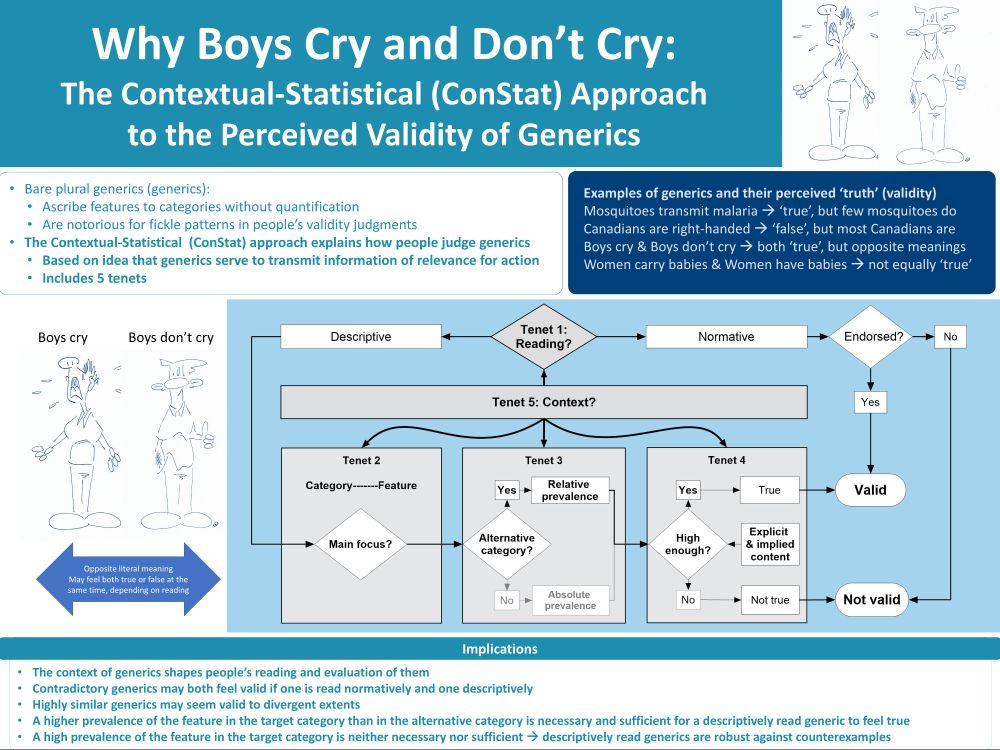
@felixhermans.bsky.social
PhD Candidate at Laboratory for Experimental Social Psychology (LESP), @KU_Leuven | Working on language and stereotypes + social (meta)cognition
(7/7) But definitely check out the full paper for much more on other types of generics and what makes them acceptable: doi.org/10.1016/j.co...
Many thanks to Vera Hoorens and Susanne Bruckmüller for allowing me to be a part of this and also to Gijs Dekkers for the lovely illustrations!
Many thanks to Vera Hoorens and Susanne Bruckmüller for allowing me to be a part of this and also to Gijs Dekkers for the lovely illustrations!
Redirecting
doi.org
September 19, 2025 at 11:37 AM
(7/7) But definitely check out the full paper for much more on other types of generics and what makes them acceptable: doi.org/10.1016/j.co...
Many thanks to Vera Hoorens and Susanne Bruckmüller for allowing me to be a part of this and also to Gijs Dekkers for the lovely illustrations!
Many thanks to Vera Hoorens and Susanne Bruckmüller for allowing me to be a part of this and also to Gijs Dekkers for the lovely illustrations!
(6/7) Returning to The Cure: we accept “Boys don’t cry” because we read this statement normatively, yet we accept “Boys cry” because we read this statement descriptively. The Cure might have thus inadvertently enforced a social norm since ‘79, oops!
September 19, 2025 at 11:33 AM
(6/7) Returning to The Cure: we accept “Boys don’t cry” because we read this statement normatively, yet we accept “Boys cry” because we read this statement descriptively. The Cure might have thus inadvertently enforced a social norm since ‘79, oops!
(5/7) In addition to integrating and building upon an extensive body of earlier work, ConStat generates novel and falsifiable hypotheses and provides practical suggestions for future research on generics!
September 19, 2025 at 11:33 AM
(5/7) In addition to integrating and building upon an extensive body of earlier work, ConStat generates novel and falsifiable hypotheses and provides practical suggestions for future research on generics!
(4/7) We propose ConStat, a Contextual-Statistical framework that builds upon earlier work to solve this puzzle! ConStat assumes that generics transmit information of relevance for individual and coordinated action and has five central tenets:

September 19, 2025 at 11:33 AM
(4/7) We propose ConStat, a Contextual-Statistical framework that builds upon earlier work to solve this puzzle! ConStat assumes that generics transmit information of relevance for individual and coordinated action and has five central tenets:
(3/7) And why does “Canadians are right-handed” sound wrong, even though the vast majority of Canadians are? These sentences are examples of "generics”. What precisely makes them acceptable versus unacceptable has long eluded researchers.
September 19, 2025 at 11:33 AM
(3/7) And why does “Canadians are right-handed” sound wrong, even though the vast majority of Canadians are? These sentences are examples of "generics”. What precisely makes them acceptable versus unacceptable has long eluded researchers.
(2/7) Back in 1979, The Cure famously wrote “Boys Don’t Cry” (www.youtube.com/watch?v=9GkV...), yet we all know that “Boys cry”. What makes us feel both sentences are acceptable? And what makes us accept “Mosquitos transmit malaria”, even though only very few mosquitos actually do?

The Cure - Boys Don't Cry
YouTube video by TheCureVEVO
www.youtube.com
September 19, 2025 at 11:33 AM
(2/7) Back in 1979, The Cure famously wrote “Boys Don’t Cry” (www.youtube.com/watch?v=9GkV...), yet we all know that “Boys cry”. What makes us feel both sentences are acceptable? And what makes us accept “Mosquitos transmit malaria”, even though only very few mosquitos actually do?
For people interested in some awesome open access work using PsyNet, see:
Gibbs sampling with people (Van Geert & Jacoby, 2024) escholarship.org/uc/item/1pc8...
Visual and auditory aesthetic preferences across cultures (Lee et al., 2025) escholarship.org/uc/item/60h1...
Gibbs sampling with people (Van Geert & Jacoby, 2024) escholarship.org/uc/item/1pc8...
Visual and auditory aesthetic preferences across cultures (Lee et al., 2025) escholarship.org/uc/item/60h1...

Using Gibbs Sampling with People to characterize perceptual and aesthetic evaluations in multidimensional visual stimulus space
Author(s): Van Geert, Eline; Jacoby, Nori | Abstract: Aesthetic appreciation is inherently multidimensional: many different stimulus dimensions (e.g., colors, shapes, sizes) contribute to our aestheti...
escholarship.org
September 10, 2025 at 2:16 PM
For people interested in some awesome open access work using PsyNet, see:
Gibbs sampling with people (Van Geert & Jacoby, 2024) escholarship.org/uc/item/1pc8...
Visual and auditory aesthetic preferences across cultures (Lee et al., 2025) escholarship.org/uc/item/60h1...
Gibbs sampling with people (Van Geert & Jacoby, 2024) escholarship.org/uc/item/1pc8...
Visual and auditory aesthetic preferences across cultures (Lee et al., 2025) escholarship.org/uc/item/60h1...

